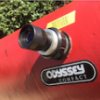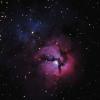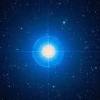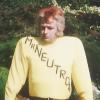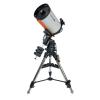
Zeiss prism or Maxbright mirror - f5 APO
#1

Posted 06 December 2013 - 01:00 PM
the maxbright t2 mirror i already have works good but the 5-10mm less lightpath of the t2 baader/zeiss prism maybe are an advantage in some situations.
what's your experience with prism+bino in combination with fast refractors?
thanks in advance
tom
#2

Posted 07 December 2013 - 10:03 AM
I tried both on my SV110ED.
I did not see much difference. The GPC/No GPC difference was dramatic at f/7, and I had thought that the Mirror would maybe offer an improvement because of the fast light cone in the diagnal prism, but any difference was subtle I would say. Again, the GPC made a huge difference for planetary.
I still use the mirror. I have in-travel to spare. In fact, with the Prism, I had to much out travel, and I felt like the extra extension of the focuser was making it a bit harder to get smooth focusing.
The mirror allowed me to rack in quite a bit making the scope more compact and reducing the moment on the tube length.
So for me, the big difference was the mechanical benefit of keeping the bino closer to the mount axis.
From a performance standpoint though, I did not notice much change.
I will revisit this one day though. I did testing on outdoor test targets so CA was easy to see and judge. At night, it is much harder to see small changes in CA I think.
#3

Posted 07 December 2013 - 11:05 AM
But I was under the impression from reading the literature on the Alpine Astro website that the difference between the T2 mirror and T2 prism was only 6mm in travel. From your comment above I can assume the difference is considerably more? -This would make it worth while for me to purchase the maxbright.
#4

Posted 07 December 2013 - 11:20 AM
didn't want to discuss length of lightpath with my post - but optical issues between prism and mirror when used with fast refractors and binoviewer ...
anyway - here you find most baader diagonal lightpath length (page 7):
http://www.baader-pl...nstruction_e...
best
tom
#5

Posted 07 December 2013 - 12:10 PM
thanks for your reply. if i interpret right, gpc vs. no gpc was a big difference - but mirror vs. prism you couldn't really see whether prism adds optical disadvantages at f7. did you use the gpc before diagonal or just before bino?
i'm wondering if there still is no/no big difference when using a f5 apo ...
kind regards
tom
#6

Posted 07 December 2013 - 01:45 PM
Are you sure you did not look at the difference bewteen the T2 standard (non Zeiss) and T2 Zeiss prisms? These units have about 5mm or 6mm light path length difference (Zeiss being a bit longer).
Also, the light path though the prisms are for f/5 as I recall, and gets longer for a slower focal ratio (I think I have that right).
I posted it here recently, but can't remember exactly.
It was 14mm difference between the T2 standard (non Zeiss) and the T2 Maxbright Mirror.
Pretty sure that was the difference. Very much more than 5mm or 6mm for sure.
#7

Posted 07 December 2013 - 01:54 PM
My scope reaces focus without the GPC and I don't use the GPC for general night time observing because for me, the real goal of the SV110 was to get a very wide field with Binoviewers.
But for planets and solar, it is a very important improvement.
I cannot really help past this, but here is my best guess.
The prism is indeed a very funny animal. The light path lenght changes with focal ratio, and the angle of the light cone is indeed very important.
Now, look who sells the Mark V in the US and how they ship it.
The Mark V is sold by Astro-Physics. And Astro-Physics, a company that specializes in fast, color free APOs, ships the Mark V with the T2 Maxbright Mirror.
And while my scope is f/7 and only 110mm, one has to consider that the larger the aperture, the more serious any spherochromatism associated with the diagonal would be come more and more important.
I do not think that it is just a accident that Astro-Physics, a company that is very deliberate with every choice it makes for ever product it sells, would have decided to package the Maxbright Mirror if they did not consider it the best choice to work with the telescopes they sell.
Knowing the quicks of prisms and the example set by Astro-Physics, my guess is that at f/5, you will do better with the mirror.
But I have not tried the Prism at f/5 and cannot give you anything more concrete than my experience with the 110ED (not an APO) at f/7.
#8

Posted 07 December 2013 - 04:11 PM
I start seeing color cast (yellow-ish) faster than around f/5.5.
I definitely see at f/4.
Unless you are looking for shorter light path, I would stay with mirror diagonal at f/5.
Tammy
#9

Posted 07 December 2013 - 04:38 PM
that's what i was afraid of - and already was a little aware of ...
the pentax scopes are f6.4 my hope was that they would be fine with the prism anyway. regarding the fsq85 f5.3 my plan was to use the gpc 1.25 in front of the prism (instead gpc 1.7 behind mirror). that way the lightcone were like f6.6 before entering the prism - and the total magnification factor about x 1.7 ...
hmmmmm
tom - who knows that you both are right - but was hoping to get a go from you
p.s. didn't ap sell the zeiss prism before - i thought they switched to mirror because availability of the prism was delicate ... ?
#10

Posted 09 December 2013 - 08:33 AM
I use the Baader Zeiss T2 prism and the T2 Baader Maxbright mirror with my FSQ106N and have goood views with both. As I have posted in the past, the mirror has slightly brighter views but some light scatter around bright planets, the prism is not as bright a view but does not have any light scatter. I think you will be fine on your FSQ85 , as the Petzal design seems to make a very straight light path after the back lens . As for your other scope, ( a standard triplet if I'm not mistaken), When I had my AP130 GT, I used a MarkV and prism ( that,s what AP sold then) with it at F6.3 and the views were good also. If you are like me, you will see a small difference between the two diagonals but that difference is small and only a matter of preference, these days, I use both diagonals regularly, and only the light path length is a factor on which one I choose.
Rex
P.S. I am really loving my 2.6GPC on the FSQ106N with MarkV's, (and with a 2" eyepiece adapter and mono use with my Leica ASPH zoom). The views are so good that I prefer using the GPC over the extender Q as the GPC is easier to install/remove.
#11

Posted 09 December 2013 - 10:12 AM
thanks for your reply - this helps a lot
if you don't have problems with the fsq106 i can't imagine some with the fsq85. the pentax 75sdhf has two lenses plus one field flattener, the 105sdp has four lenses and seems to be the same petzval design as fsq but a little slower.
having received your post i ordered one now - they are currently sold out here in germany - delivery is scheduled for end of january ...
thank you again
kind regards from bavaria
tom
p.s. waiting is always a little annoying - but this time it's not too hard for me because i got so much wonderful new MADE IN USA gear the last two weeks - wimberley head, 2 x pan19, 2 x pan24, discmount dm4, skycommander, sky quality meter, ap 2" maxbright
#12

Posted 09 December 2013 - 09:26 PM
p.s. didn't ap sell the zeiss prism before - i thought they switched to mirror because availability of the prism was delicate ... ?
Yes, that was the reason given.
#13

Posted 19 October 2014 - 05:11 AM
... it took nearly half a year until the zeiss prism finally arrived - and while from may during the summer my mountainbike season takes priority ...
so - ok - it's here - looks good (as looking through also looks good). the biggest point for me to switch from T2 maxbright to zeiss prism was the shorter lightpath to come in focus without removing the camera angle adjuster from my tak. now i just have to open the baader 2" ultrashort clamp to change between 2" mirror, baader mark v and fuji x pro1 camera - and all come in focus within focuser range.
#16

Posted 19 October 2014 - 05:29 AM
the two pix above - shot with fuji x pro1 through direct attached mirror/prism within 2-3 minutes - tree distance was about 150 feet.
what do you all think about the both samples - not really a difference? hope this will be the same when watching moon, planets and stars in the night!?
but for now it looks as if the fast f=5.3 takahashi fsq 85 ed works well with a directly attached prism ...
kind regards
tom
#17

Posted 19 October 2014 - 08:57 AM
With just to pictures it is not conclusive, but I have to tell you that I think the mirror diagonal picture is quite a bit sharper.
Studying the bright green leaves closely, I see that there is more fine, low contrast detail visible in the mirror. The camera plane is working at 1x, so if this is correct, then what happens when you use the eyepeice at 100x?
There is this though. The focal point seems to be different in the pictures. There are some leaves in the "hole" at lower left center that look more out of focus in the mirror picture, and a different focus point means that it is hard to trust the pictures.
But when I look at the picture, I see better fine detail, low contrast detail, and color satuation in the mirror picture. Bottom line.. The mirror picture looks better to me.
#18

Posted 19 October 2014 - 09:01 AM
If you want me to identify specific details that I am looking at to make my judgement, give me your permission to download the pictures and I will crop them up with pointers and re-post them.
And again, you have to remeber that at 1x, detail differences are not nearly as easy to see as at 100x, and if the goal is for visual use, that is what you should be imaging. You should do the test using afocal projection if you can. That is how you really see any differences. These low powers simply don't provide enough angular resolution to really see how the diagonals compare, but again, my eyes see the mirror picures as being better.
#19

Posted 19 October 2014 - 09:44 AM
hello eddgie,
for me it's really hard to see any difference in the pictures ... i send you a private message with a link to download the raw files from our server. eyepiece projection i don't have the equipment for. but what i will do next time are some pictures with the baader ffc behind the prism (if i come to focus) ... this should give better results to judge. maybe i could try taking a photo with iphone through delos eyepieces with gwk 1.7 and mark v ...
#20

Posted 19 October 2014 - 09:50 AM
With just to pictures it is not conclusive, but I have to tell you that I think the mirror diagonal picture is quite a bit sharper.
Studying the bright green leaves closely, I see that there is more fine, low contrast detail visible in the mirror. The camera plane is working at 1x, so if this is correct, then what happens when you use the eyepeice at 100x?
There is this though. The focal point seems to be different in the pictures. There are some leaves in the "hole" at lower left center that look more out of focus in the mirror picture, and a different focus point means that it is hard to trust the pictures.
But when I look at the picture, I see better fine detail, low contrast detail, and color satuation in the mirror picture. Bottom line.. The mirror picture looks better to me.
+1
#21

Posted 19 October 2014 - 10:16 AM
... btw. are you really shure about the 1 x magnification thing ... i would have guessed that it only depends on the pixle density of the camera chip compared to the sensor density of human eye ...
this is a 1.5 crop chip - a 35 mm lens compares to human eye - equivalent for 450mm is 12x.
regarding camera lenses - CA and other errors are easy to find in 100% viewing the pictures - even on very expensive lenses.
anyway ... i don't know ...
Edited by tom63, 19 October 2014 - 10:18 AM.
#22

Posted 19 October 2014 - 10:31 AM
If you think that the results are similar enough not to be worried about it, then that is all that counts. I think both pictures are good, and any differences are tiny, and if you think that the images show comparable performance, then your own judgment is far more important than mine.
When I looked at the pictures, I thought that the mirror picture appeared to show a bit more very fine detail.
But I was quick to say that it was inconlusive because the point of best focus appeared to be slightly different.
This is why I long ago abandoned trying to test using natural subjects or the sky. Far better to use a fixed test target of known and unchanging characteristics, with controlled lightling. I recommend using a fresh $20 bill as far away from the lens as you can get it, and with a controlled artificial light source. Using these kinds of outdoor test targets when trying to differentiate tiny levels of performance has always seemed to yeild less conclusive results for me than using indoor test targets.
Anyway, if you are happy with the result, this is the very most important thing.
The other test you can do is to use a bright star to check for spherochromatism. If you see more fringing in the prism, that would indicate that the spherochromatism is altering the image, but if there is already fringing present, telling the tiny difference between brightness can be difficult. A night time star at 100x though would to me be as good a test as any. If there is any induced spherochromatism, it should be evident in the amount of color frining on an Airy Disk at high power.
Edited by Eddgie, 19 October 2014 - 10:35 AM.
#23

Posted 19 October 2014 - 10:59 AM
eddgie ... no i'm not shure that prism is as good as mirror ... that's why i made this post. when looking at the two pictures i can't see a real difference - the small differences you see on green leaves - maybe i don't see them because i have a medium red/green handicap. what i see in the pictures is that in daylight conditions it seems to be not a real big thing between mirror and prism even on the fast 5.3 telescope. i was wondering/hoping if this will be the same at night with stars/moon/planet. did you download the raw files?
#24

Posted 19 October 2014 - 11:35 AM
... now my idea (if false - please correct) is to try the scope with prism->gwk 1.7->mark v->delos 12mm=>63 x - if moon and stars don't have ca it should be fine for me.
for higher magnification i do not have eyepieces with shorter focal length - instead i wanted to use the baader ffc in front oft the prism. the resulting light-cone then shouldn't be a problem for the prism and the behavior of the eyepieces i hope is more forgiving and easier to look in than very short focal length eyepieces with wide fields ... all just (my) grey theory ... no really knowledge. what are you thinking?
#25

Posted 19 October 2014 - 05:06 PM
I think that a better target is a bright star, but yes, if you can't see any change in the level of fringing, then I would say you are fine.
And for low power work, it really does not matter anyway, so if you are mostly going to be using this for larger, brighter objects, then a bit of sphrerochromastism is not going to matter.
But if you can't see any change in fringing between the two prisms, then it does not matter.
Comparisons need to be made with the GPC in place. I could see a meaningful change in CA when I used the Mark V with and without the GPC when binoviewing my SV110ED. The scope itself is not color free, but on the sun, the GPC made a very meaningful difference. Again, this was for the Binoviewer, and not the prism. I think there was perhaps a very tiny difference between the prism and mirror, but honestly, I don't use the scope for planets, and I use the Baader Solar Continuum for white light.
I noticed the difference on the sun before I started using the SC filter. This told me that for best high power performance when using a fast refractor, the GPC for the binoviewer should be used. Again, I did not really compare in any critical way the difference between the prism and mirror because for my own purposes, it did not matter.
But I may do this next time I am doing some solar observing. Maybe I will take out the wedge and put the full aperture filter on and compare the mirror to the diagonal.
The sun is a very harsh subject. If there is CA, you can't miss it when viewing sunspots.

















